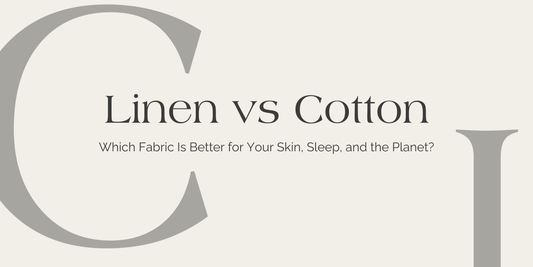For decades, cotton has been the go-to fabric for everything from clothing to bedding. It’s soft, familiar, and affordable. But in recent years, more people have been asking a deeper question: when it comes to what we put next to our skin every day, is cotton really the best option?
In this linen vs cotton comparison, we’ll explore how each fabric affects your skin, sleep quality, and overall well-being—along with their environmental differences.

Linen vs Cotton: Breathability and Your Skin
When choosing a fabric for everyday wear or bedding, breathability isn’t just about comfort—it’s about skin health. Linen, made from the flax plant, allows for significantly better airflow due to its looser weave and naturally hollow fibers. It doesn’t trap heat or moisture, making it ideal for warm climates, night sweats, or anyone with sensitive skin.
Cotton is breathable too, but its tighter weave and moisture-retaining properties can cause heat to linger. Sweat gets absorbed, but not wicked away, which may lead to breakouts, irritation, or just that sticky, uncomfortable feeling on warm days.
If you’re trying to prevent skin flare-ups or keep your body temperature balanced, linen vs cotton isn’t just a style preference—it’s a health decision.
Linen vs Cotton: Hypoallergenic Benefits and Bacteria Resistance
Another standout benefit of linen is its natural hypoallergenic and antibacterial properties. It resists dust mites, mold, and bacterial buildup without needing chemical treatments. This makes it a great choice for allergy sufferers or anyone with eczema or sensitive skin.
Cotton, while soft and gentle, retains more moisture, which can promote bacterial growth if not washed frequently. If you’ve ever woken up with skin irritation and blamed your detergent, your fabric might be part of the problem.
In the linen vs cotton discussion, linen earns high marks for creating a cleaner, lower-irritation sleep environment.

The Myth of Softness and Fabric Irritation
Cotton’s softness is legendary—but sometimes, it’s manufactured. Much of that out-of-the-package smoothness comes from synthetic finishing agents that wear off after a few washes. And for sensitive skin, those added chemicals can cause irritation.
Linen starts out with more texture, yes—but it softens naturally over time with every wash. It doesn’t rely on silicone washes or softening sprays. Instead, it evolves into a light, breathable softness that molds to your body without clinging or trapping heat.
Many people who make the switch say the adjustment period is short—and the comfort rewards are long-term. When comparing linen vs cotton, natural softness often beats artificial.

Linen vs Cotton: Durability Means Fewer Irritants Over Time
Linen is famously strong—about 30% more durable than cotton. This means it won’t pill, tear, or fray as quickly. And from a skin-health perspective, that’s good news. Worn-out fabrics tend to shed more microfibers, which can cause minor abrasions or increase allergen exposure.
Cotton, especially high-thread-count cotton, may feel smooth at first but often wears down faster. That means more replacements, more finishing chemicals, and more skin exposure to new treatments and dyes.
In the linen vs cotton debate, durability isn’t just about value—it’s about reducing contact with breakdown byproducts.

Sustainability and Skin: A Hidden Link
While this article focuses on fabric and health, sustainability is never far behind—and it matters more than you might think for your body.
Flax, the source of linen, grows with little water, no irrigation, and far fewer pesticides than cotton. It’s processed with fewer chemicals, which means less residue stays on the fabric. Linen is also biodegradable and typically used in its pure form, with fewer synthetic blends.
Cotton, particularly when conventionally grown, is water-intensive and chemical-heavy. Even “natural” cotton can contain residues from pesticides and fertilizers used during growth.
So when comparing linen vs cotton, flax-based fabrics come out cleaner—not just for the planet, but for your skin too.

Linen vs Cotton: Which Should You Choose?
If you prefer softness from day one and are looking for the most accessible option, cotton still has its place. But if your priority is breathable comfort, fewer skin irritants, long-term softness, and a cleaner ecological footprint, linen is the smarter choice.
It may feel like a change at first—but it’s one your skin (and sleep) will thank you for.
Further Reading
Looking to go deeper into how linen performs in everyday use—especially for bedding? Check out our Linen vs Cotton Sheets Guide for a more product-specific comparison.
For a broader sustainability analysis, this Treehugger article on linen vs cotton explores environmental impacts in greater detail.
If you’re curious about how linen stacks up in terms of quality and longevity, our blog Good GSM for Linen Bed Sheets: How to Choose the Right Weight breaks down what fabric weight actually means—and why it matters more than thread count when it comes to everyday comfort and durability.
Still wondering if all linen is created equal? Read Don’t Buy Bed Linen Until You’ve Read This to learn how to spot authentic, high-quality linen versus the mass-produced versions that don’t hold up over time.
Choosing between linen and cotton isn’t just about feel—it’s about long-term value, health, and how your bedding works with your lifestyle.






